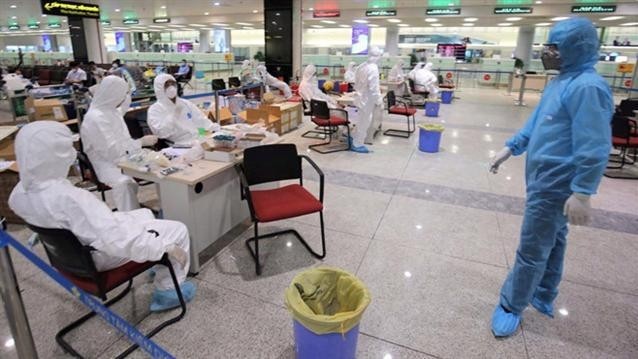This is a positive signal showing the effectiveness of the solutions put forth by the Government, the National Steering Committee for the prevention and control of the pandemic, and the Ministry of Health.
However, the pandemic is still producing complicated developments where outbreaks in the community and health facilities have been reported, requiring drastic preventative measures against the pandemic, with the utmost due diligence in their implementation.
Right from the beginning of the pandemic, the prevention and control of infection in healthcare workers was determined to be one of the top priorities and more measures are needed to protect medical workers in the current period. Medical workers are the soldiers at the front lines in the fight against the pandemic.
At the hospitals, measures to protect health workers have been implemented under specific scenarios. After the first medical staff at the Centre for Tropical Diseases in Bach Mai Hospital were found infected with COVID-19 virus, the entire centre was closed and 150 doctors, nurses and other staff working at the centre were isolated while they were all tested for the virus (all were negative).
Similarly, a number of healthcare workers at E Hospital, Vietnam-France Hospital, Duc Giang Hospital, Hanoi Obstetrics and Gynecology Hospital, the National Institute of Hematology and Blood Transfusion, and others were immediately isolated and tested for COVID-19 after they were confirmed to have had contact with COVID-19 patients no.237 and no. 243.
Although medical workers are fully equipped with protective equipment, it is reasonable to isolate and test all of them who have had contact with COVID-19 patients to prevent the infection to other health workers and the community in general.
This is a critical strategy that the National Steering Committee for the prevention and control of the pandemic has constantly outlined and also required medical units to implement right from the beginning of the outbreak and it will continue to be maintained..
Risk of infection in the hospital is always possible, because screening and testing for the virus is often conducted at hospitals. If medical contact and examination do not uphold safety standards, the risk of infection in health workers is likely to become a reality.
Therefore, hospitals need to strengthen measures to prevent and control virus infection in their health facilities. Based on the current situation, all patients who come to examination facilities with symptoms or an unclear epidemiological history will be tested for the COVID-19 virus or isolated and transferred to the appropriate treatment facilities.
Health facilities must strictly comply with all regulations and professional instructions on receiving, screening, examining, quarantining and transferring people suspected of carrying COVID-19 virus.
In particular, adequate and standard personal protective equipment must be provided to all healthcare workers when examining and treating infected or suspected COVID-19 patients.
Medical workers are required to wear sufficient protective clothing (gloves, hats, masks, glasses, etc.) for their entire working time at the hospital, instead of only using them when in contact with patients as was the case before.
As well as this, special attention should be paid to anti-bacterial solutions because COVID-19 patients are not only concentrated in central hospitals, but also at district or commune-level health facilities. Therefore, hospitals need to obey the standard process on infection control and isolation. Once there is a standard process, workshops and training must be held regularly (even when there is no disease) to gain experience and raise awareness amongst all medical staff.
The fight against the COVID-19 will be a long one. Besides protective measures to minimize the risk of infection to the frontline healthcare workers, there needs to be a joint effort and full support from the community so that healthcare workers can be confident in their work to combat the pandemic.
















